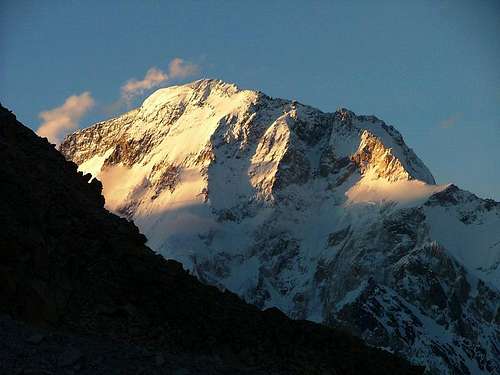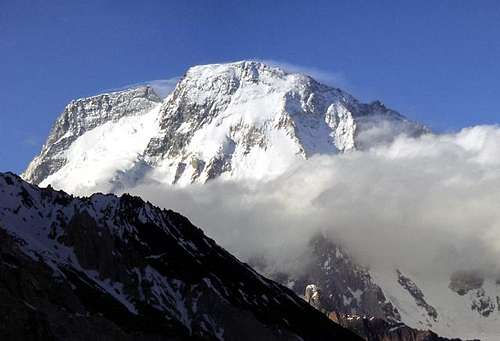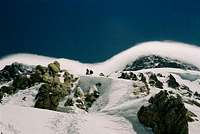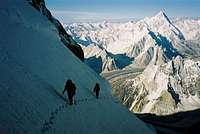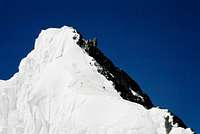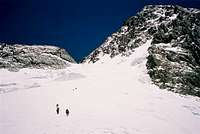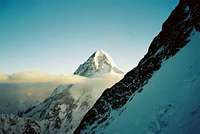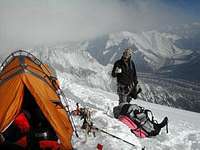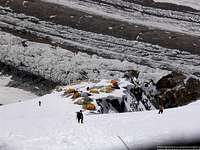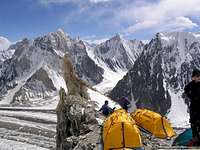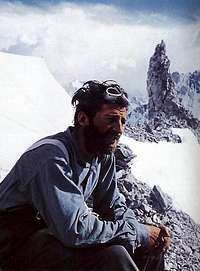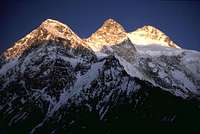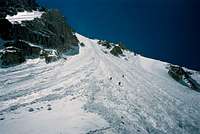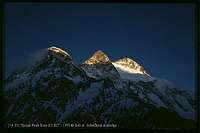|
|
Mountain/Rock |
|---|---|
|
|
35.81600°N / 76.56200°E |
|
|
Mountaineering |
|
|
26401 ft / 8047 m |
|
|
Overview
Location and name
Broad Peak, the 12th highest mountain in the world at 8,047 meters, is located in the Karakoram Range in Northeastern Pakistan. The mountain is located along the western Baltoro glacier between K2 and Gasherbrum IV.
The first westerner who saw the peak was probably Lieutenant T.G. Montgomerie. He was surveying the mountains in the area and in 1856 he spotted some extraordinary peaks, which he gave temporary names. K for Karakoram + a number for the peak. K1, K2, K3 etc. Montgomerie later found out K1had a local name; Masherbrum. K2, still goes under that name, even if some have proposed to re-name it Qogori, a name used by some local people. K3, the third peak to be measured by Montgomerie didn't have a local name.
The summit ridge of the peak is almost 2 km long and therefore British explorer W.M. Conway thought Broad Peak was a suitable name.
Conway noted: "a fine breadth of mountain splendour...a huge Breithorn, as it were, filing the space between K2 and the hidden Gasherbrum." The name won general acceptance, but some zealots on a mission to get rid of all western names wanted a local name on the peak. They did not find any credible name candidates, so they did what they considered second best: they simply translated Broad Peak into Balti, the local Tibetan dialect. The name - P'alchan Kangri/Ri. It became a bit bastardized over the years and is nowadays spelled and pronounced Falchen Kangri, which is completely off the mark as there are no "f-sounds" in Balti.
One or two 8000m peaks?
A sometimes raging debate about Broad Peak having one of two "real summits" has been going on for a long time. Most people agree on the fact the central peak is not a separate summit, but the advocates in favor of counting it as one points at the snow on the col in between this summit and the main summit. If the snow are melting due to global warming, Broad Peak central might qualify as the 15'th 8000m peak. Another issue connected to global warming is the fact that the snow on the true summit is melting and the fore summit may overtake it in height. This would be welcomed by climbers as the trickiest part of the whole climb would disappear.
First ascents of the main summits
Broad Peak has three seperate summits: main summit 8,047 meters, central summit 8,016 meters, and north summit 7,550 meters.
The first ascent of the main summit was made in 1957 by an Austrian expedition consisting of only four climbing members. Using many of the fixed lines set up by the failed German expedition of 1954, all four summited without using oxygen. Hermann Buhl, Fritz Wintersteller, Kurt Diemberger and Marcus Schmuck didn't have the help of any HAPs (high altitude porters) or guides and the climb was a remarkable success for alpine style climbing, as it occurred well before the time of small independent teams attempting the highest peaks on earth.
Broad Peak Middle was climbed by five members of Polish expedition: Marek Kesicki, Bohdan Nowaczyk, Kazimierz Glazek, Janusz Kulis and Andrzej Sikorski. They summited on 28th of July 1975. Kesicki, Nowaczyk and Sikorski died during the descent.
The leader of this expedition was Janusz Ferenski.
jck helped out with info on this.
The north summit was finally acquired in 1983 by an Italian expedition led by Renato Casarotto.
Climbing Broad Peak
From the first ascent in 1957 to August 2003, Broad Peak was climbed 255 times and had 18 deaths. The fatality rate is therefore about 7%, which could be compared with for example Everest which has a death rate of 9%. It is one of the safer 8000m peaks, but the risk of avalanches should never be disregarded.
More about this.
Many teams today use the moderate climbing on Broad Peak to acclimitize for a rapid alpine style ascent of K2. The main route to the summit, via the west ridge, is moderately strenuous, but like other mountains in the Karakoram range, weather is often the determining factor.
Only 5 people have climbed twice and no-one more than that.
To the true summit or not?
Broad Peak is as Xixabangma and Cho Oyu a peak where a huge majority of "summiteers" don't reach the true summit. A lot stop at the fore-summit and claim to have climbed Broad Peak. In 1994 Hans Kammerlander was sick of this and left a piece of red and purple rope, attached to a ski pole on the summit and asked other climbers what they had seen up there.
Later Ascents
1984 One astonishing ascent occured in July of by the amazing Polish climber Krzysztof Wielicki. He left base camp at 4,850 meters at midnight, reaching camp1 at 4am, camp2 at 8am, the col at 2pm, and the main summit by 4pm. His ascent of 3,150 meters in less than 14 hours was an incredible achievement for its time. He completed the round trip in just over 22 hours, all solo. This solo ascent of an 8,000 meter peak in a day was not repeated until 1986.
1994 Even faster than Wielicki was Swede Göran Kropp when he soloed the peak in 18½h.
1982 Jerzy Kukuczka and Wojciech Kurtyka read their climbing permit for K2 carefully. it said: Acclimatization on lower peaks in the area allowed.
As Broad Peak is lower than K2, they came to the conclusion it may be allowed and went for the summit as a step in the acclimatization process. On the way up they met Messner, who asked them if they had summited. Kurtyka told messner: We were in the area. Messner smiled and said: Yes. Yes. Understood. He further promised not to tell anyone about the meeting. Messner kept quiet until he released his book "Three Times Eight".
2013 Maciej Berbeka, Adam Bielecki, Tomas Kowalski and Artur Małek reached the summit of Broad Peak (8051m), making the first winter ascent of the Broad Peak. Unfortunately the success was soon over shadowed by the fact that Maciej Berbeka and Tomasz Kowalski got lost on the descent.
More about the first winter ascent here.
See the booklist for Kukuczka's and Messner's books about this incident and more interesting reading about their climbs of all the 14 8000'rs.
A list of all summiteers!
Scott adds:
Broad Peak has also been attempted in the winter. The rocky summit (lower part of main summit) (8,016 meters) was climbed in the winter by Maciej Berbeka of Zakopane, Poland in 1988. Maciej mistook this summit for the main summit in poor weather. In 2003, a Spanish team attempted a winter ascent, but were turned back by extreme wind and cold. Several camps were destroyed, but luckily no-one perished.
Getting There
Broad Peak is a long way from any arrival point in Pakistan. Sooner or later you have to pass Islamabad as this is the town where you get the permits for the peak. If an organizer have taken care of the arrangements for you, you can just relax and follow your guide through the country. If you want to arrange everything yourself, the following may be of help.
From Islamabad to The Northern Areas.
Local buses serve Islamabad with Skardu (the normal starting point for the trekking) well. Catch a bus from NATCO or Masherbrum Tours from Pirwadai i Rawalpindi (twin city of Islamabad, 15 km away). The cost for the 22-30h journey is about 12 US$. A taxi from central Islamabad will cost you 200-300 Rps. Some buses stop overnight in Besham, some go straight through to Skardu. If you have booked a ticket on a direct bus, don't be surprised if you have to wait in Besham for some time. Usually this wait is for other buses to gather and also for the police/military to ready a convoy. There are almost always some minor unrest in Indus Kohistan and to play it safe, the authorities arrange a convoy for the night traffic. It's nothing to worry about, it's standard procedure in this area.
From Skardu to Broad Peak.
There are two routes to the peak from Skardu - via Askole or via Gondogoro Pass. The former is to recommend if you're not acclimatized. Gondogoro Pass is a mighty 5600m, so most trekkers use this route for the way back.
To Askole.
A jeep ride takes 6-8h on partly miserable roads and the going price in the summer of 2005 was 3500-4000 Rps.
In Askole you can either camp out in the wild or use the one of the camping places, which will cost you 100 Rps. Facilities includes toilets, running water and a grassy, walled camping area.
The first camp site along the route is Jhula. It takes anywhere between 4 and 8 hours to reach Jhula from Askole and the trek is very straight forward. Most of the time you walk on good paths along a river. An early start is recommended as it gets very hot in this area. Two bridges where you have to pay a small fee have to be crossed. Jhula has shower cabins, running water, toilets and camp platforms. 100 Rps./night.
Normally, there is not a problem to reach Paiju the second day. The trek is harder as you sometimes walk in sand along the rivers and there are some ups and downs en route. Paiju has the same facilities as Jhula and the cost to camp there is also 100 Rps./night. The place can be very crowded in the high season and if you don't like that, just continue for another 20 minutes to the first stream or to where the glacier start, where a very good place to camp is situated. Fresh water available here.
The next camping place is Urdukas, which has very good views of the Trango group. The camp site is situated on a hillside with good camp spots. Facilities and price is the same as Jhula and Paiju. If you want to go further or a part of the way to Urdukas, remember you'll be camping on the actual glacier. Campspots can easily be found there as well, but in some parts there are half an hour in between good or/and safe ones.
From here on the lenght of a normal day trip varies a lot depending on how the persons in the group feel. There are some camps along the way, but they are all very basic, consisting of shelters built of rocks. Most groups stop at Goro II, some stop an hour before this camp, Goro I and some go all the way to Concordia.
Concordia, which could be one of the most beautiful places on earth is sadly full of garbage and human waste. To the left you can see Broad Peak and K2. Ahead you Gasherbrum IV is looming and to your right is the impressive Mitre. No fees and no facilities in Concordia.
The rest of the way to Broad Peak BC is an easy 3-hour walk on upper Baltoro glacier. The way out of Concordia can be a bit confusing. Ask a local if uncertain.
Walking out via Gondogoro Pass
Gondogoro Pass (or La as it is in the local language) is sometimes stated to be the highest pass in the world and the altitude given on many maps are over 5900m. It's not that high, but at 5600m it's still a very impressive pass. Many teams choose to walk out this way because of the outstanding views from the pass summit. Masherbrum (7821m) is very close and to your NW you see the whole Gasherbrum group, Chogolisa (7665m), Baltoro Kangri (7800m) and a lot of other high beautiful peaks. To the north K2 and Broad Peak are visible. In the south the extraordinary Laila Peak can be seen.
From Concordia it's a long day's walk to Ali Camp. First you walk past Mitre Peak and head up the next valley/glacier on your right hand side. Watch out for rock falls when entering the valley and try to gain access to the icy part of the glacier as soon as possible. Better to walk up there then down in the scree. When approaching Ali Camp, watch out for crevasses. The "security team" of Ali Camp will scream at you, where and where not to walk.
Ali Camp has a 100 Rps./night fee. Ridiculous prices for "nature preservation" (there's loads of garbage all oer the place), "guiding services" (I never saw any guides when I walked over the pass) and "security" (some bad plastic ropes, attached in extremely bad way is to be seen close to the summit of Gondogoroa Pass) has to be paid. For 1-3 persons it's 2500 Rps. For 4-8 persons it's 4500 Rps. The pass is privately owned. That is probably why this scam can go on as it does. My advice is to bugger the "guides" staying in Ali Camp about the garbage and not trusting the ropes at all.
I was told the it would take 5-7 hours to reach the pass from Ali Camp. It took me 2.45. For an acclimatized mountaineer, this is probably normal. It can be very windy on top of the pass, as it is a lot of elevation drop on the SW side. Don't trust the ropes on this side either. It's quite steep on this side (40-45 degrees). Stay up high on the right hand side if no tracks. There are glaciers in the middle of the glacier further down. The path gets really good before the little camp site of Xhuspang/Shispang, where you also can get very basic meals.
The glacier gets more difficult to travel after the camp and when you have passed the first rocky part and entered the main valley, stay to the left all the time. Doing so makes you avoid all the large crevasses and the left hand side is also the side you leave the valley on. When at the bottom of the first valley, take a left and enter some very nice meadows with yaks. Excellent views of sharp peaks. Some tricky, slide sections have to be passed. The walk gets easier again when heading down the lower part of the Gondogoro glacier towards Shaishcho. In this little settlement you can eat and pitch your tent under nice-smelling wild roses. 100 Rps./night per tent.
From here it's a very easy 3 hour walk to Hushe.
The Hushe - Skardu road is of awful condition for the first couple of hours. In the summer of 2005 the road had been badly cut away by a big river and all travellers had to walk over a wild river on small logs. Other jeeps were waiting on the other side. Lots of apricot orchards followed. From close to Khaplu the road is asphalt all the way into Askole. Count on 5-8 hours from Hushe to Askole.
Routes Overview
- Standard Route - West Ridge
1957 - Austrian. Wintersteller, Diemberger, Buhl and Schmuck. - Carsolio Route - West Ridge to South Face
1994 - Mexican. Carsolio. - The Long Summit Ridge Traverse
1984 - Polish. Kukuczka and Kurtyka. - South West Face
2005 - Russian/Italian. Urubko and Samoilov.
Link
Red Tape
Visas:
Visas are required by nationals from most European and English-speaking countries. Validity period and cost varies a lot depending on which passport you carry.
Some Pakistani Embassies around the world
Visa extensions are available in most major cities in Pakistan, but should be avoided in the really large cities as it can be a long and nerve-wrecking experience. For Broad Peak climbers, Skardu is a recommended place for extensions. See also the Skardu section
Permits for Broad Peak
You need a permit to climb the peak, which you can get hold either via the Ministry of Tourism or via an expedition agent. The fees were dropped to half of the old price some years back and the going prices for 2005 are as follow: - K2's royalty fees: 6000 USD for a team of seven, 1000 USD each additional climber.
- All other 8000ers, Gasherbrum I and II, Nanga Parbat, and Broad Peak: 4500 USD for a team of seven, 750 USD each additional climber.
- 7500 to 8000 meters: 2000 USD for a team of seven, 250 USD each additional climber.
- 7000 to 7500 meters: 1250 USD for a team of seven, 200 USD each additional climber.
- 6000 to 7000 meters: 700 USD for a team of seven, 100 USD for each additional climber.
A trekking fee is also appliciable in the Broad Peak area. It's US$50.
If you join a commercial expedition you don't have to think about the fees for the liaison officer (LO) which is a must in this area of Pakistan. If you walk in via Askole, you need a LO all the way from the military checkpoint some hours out of Askole. If you choose the Gondogoro Pass/Hushe option you can walk in without a LO. When you climb the Broad Peak, every group needs to have a LO attached.
If going independently, you're supposed to pay the salary for the LO. Here's the full story, which also give you info about the obligatory briefing and de-briefing.
An environmental fee of $200 also have to be taken into account. There's a refundable bond of $6000 which most expeditions have to pay. Count on it. I was probably just lucky no one asked me about it.
If you attempt a peak lower than 6500m in this restricted area, a Ministry of Tourism approved guide has to be in your company. It's is much cheaper and straigh forward than dealing with a LO.2010
Karrar Haidri, representing the the Executive Council Alpine Club of Pakistan forwarded me the following information.
Government of Pakistan vide Notification. 1(1)/2002-OP, dated 15th October 2008. In suppression of all previous notifications regarding announcement of concessions for Mountaineering, Ministry of Tourism, Government of Pakistan has decided to continue reduction in royalty fee during the calendar Year 2010 as per details given below:
1. Zero royalty fee for peaks up to 6500-M.
2. 10% royalty fee on mountains situated in Chitral, Gilgit and Ghizer except on Spantik/Golden Peak.
3. 05% royalty fee on all peaks during winter season (December- February).
4. 50% discount on royalty fee on all peaks except as mentioned in (1) and (2) above as per following break-up:
The prices after reduction:
K-2 8611m $6000 for 7 member for additional member $1000
8001-8500m $4500 for additional member $750
7501-8000m $2000 for additional member $250
7001-7500m $1250 for additional member $200
6501-7000m $750 for additional member $150When To Climb
June to September is the normal climbing season.
Broad Peak has also been attempted in the winter. The rocky summit (lower part of main summit) (8,016 meters) was climbed in the winter by Maciej Berbeka of Zakopane, Poland in 1988. Maciej mistook this summit for the main summit in poor weather. In 2003, a Spanish team attempted a winter ascent, but were turned back by extreme wind and cold. Several camps were destroyed, but luckily no-one perished.
Camping
It's allowed to camp anywhere along the route to Broad Peak. Most climbers who go to the area have bought a package deal from an organizer and therefore a high majority of campers stay in the official campsites along the way. Some of them are clean and well-equipped places, some looks more like garbage dumps (Ali Camp and Concordia) and some are only detectable by some spartan wind shelters built by piled up rocks.
Apart from the camps at Paiju, Jhula and Urdukas there is no reason to stay at the official places as they often are crowded and noisy places.
Pitch your tent anywhere, but be careful with the water conditions close to places where many people camp or have camped.
Photos from the camps up high
Recently some very good photos from the higher camps on the peak has been submitted. This section is dedicated to these images.
Mountain Conditions
Broad Peak is located very close to Concordia, one of the biggest mountaineering camps in the area. During the whole climbing season there are lots of expeditions there. Many of them have satellite communication capability and many of them are also online on a daily basis, i.e. you can get plenty of info about the weather.
The K2 weather report also apply for Broad Peak
Main site of Adventure Weather.com
The Pakistani army people on the Baltoro glacier keep a close check on the weather. Another good source of info.
Porters
Contrary to what some organizers are telling you, you can arrange the trek all by yourself.
The porter salary system was strict and worked fine until 2004, when massive amounts of climbers arrived for the K2 anniversary. A shortage of porters made some organizers desperate and they had to bid over the governmentally fixed prices. This created havoc and the whole porter salary system collapsed.
The cost for a porter is now down to your bargaining skills. Officially it should be roughly 3300Rps. to Broad Peak BC, but count on paying as much as 4500Rps.
Porters can be found in Askole, but if there are a lot of expeditions leaving when you get there, there's a high risk there is none available. Better book beforehand. The organizers are not very happy to help you out with this, as they want to include you in a group, but the small hotels in Skardu can usually help you. The price mentioned above is the full price, which include sunglasses, gloves etc. for the porter.
What is not included in the price are the below items and you have to supply the group of porters with the following: - A kerosene stove
- Kerosene
- A tarp or a sheet of thick plastic which serves as a tent/shelter.
- Food
All the above is best bought in Skardu.
Food/porter 1100-1300Rps.
The rest on the list 600Rps. (10 litres of kerosine).
You can choose to pay the food money directly to the porters, or you can walk around with them and buy the food. Discuss it with the porters and come to an agreement.
If you walk out via Gondogoro La/Pass try to find porters living in Hushe. The porters coming from the lower parts of the Baltoro glacier are much more prone to strike or turn around then the Hushe porters. The latter just want to have the job done/going home and are very seldom creating any trouble.Skardu
Skardu is a little town where you'll spend a day or two and is the last outpost of "real civilisation". Some info that may be useful. - You can extend your visa here, regardless of what some organizers tells you. Go to the DP (Deputy Comissioner) Office. It takes an hour or two to get the one month extension. Prices depends on your nationality. The DP Office is to be found in the nothern end of town, close to the K2 Guest House.
- There are plenty of hotels in Skardu. The top end places are K2 Guest House and Masherbrum Hotel. The former is known for it's cozy garden and the latter for over-priced food. Prices ranges in between 1500-2000 Rps./night. Cheaper alternatives are to be found along the main street. A good value hotel is Gasherbrum Hotel on the main street. 300 Rps./night for a large double is a good deal and the food in the hotel's restaurant is excellent and the portions are monstrous of size.
- Camping and mountaineering shops sells everything you can find in their equivalents in the west. Prices varies. Gas canisters for example, are expensive, but down-suits can be bought for 200US$! Almost everything here is second hand.
- Food shops. There are plenty of them along the main street. Don't expect to find much more than the staples. You can find all the necessary food here if you're not picky and can put up with pasta, soups, porridge etc. for the weeks at Broad Peak.
- If you hire your own porters, you better buy the stuff they need in Skardu. Further up the valleys it'll be way more costly and it's not 100% you'll find what you look for. See the porter section for more details about this.
More Books & Links
Bill Buxton's article in The Canadian Alpine Journal.
A full account on the 1957 first ascent expedition to Broad Peak.
On Hermann Buhl's Memorial site you'll find a lot of books.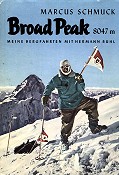
The official book about the first ascent of Broad Peak Written by Marcus Schmuck. In German.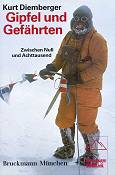
Gipfel und Gefährten Includes the first ascent of Broad Peak, written by Kurt Diemberger. In German.
On top of the world Written by Richard Sale and John Claere. The history about all the 14 8000'ers.
There's another book written by Richard Sale, called Broad Peak ISBN 0953863115 English.
Fritz Wintersteller one of the four first summiteers of Broad Peak, reviews the book as follows:
Carreg 2004. This the first full account of the 1st ascent of Broad Peak in 1957 by Marcus Schmuck, Fritz Wintersteller, Hermann Buhl and Kurt Diemberger, drawing on the climbing diaries of Schmuck and Wintersteller and accounts written by Buhl. None of this material has ever been published before.
The account is supported by conversations with Kurt Diemberger and with Qader Saeed, who was the expedition's Pakistani liaison officer. The book includes an account of Buhl's last climb and death on Chogolisa, from the protocol written by the surviving team members on the day Diemberger returned to Base Camp after the accident. The book begins with a history of Broad Peak, including the first ever drawing of the mountain (from Martin Conway's expedition of 1892), the first ever photograph (from the Eckenstein expedition of 1902) and Vittorio Sella's panorama from the Duke of Abruzzi expedition of 1909.
There is also an account of the first attempt on the Peak by the Karl Herrligkoffer expedition of 1954. The book ends with an Appendix of all summit climbs from 1957-2004. The photos from the 1957 expedition are almost entirely from previously unpublished work of Schmuck and Wintersteller.
One of the most impressive Himalayan ascents of the last century was Austrian party of Marcus Schmuck, Fritz Wintersteller, Kurt Diemberger and Hermann Buhl’s 1957 first ascent of Pakistan’s 8,047 m Broad Peak.This was achieved by a small team without artificial oxygen who ferried all the loads to the high camps. The trip ended with the tragic death of top Austrian climber Hermann Buhl, who fell through a cornice duringa reconnaissance of Chogolisa.
Now, this book by Richard Sale, Broad Peak, discusses the dynamics between the climbers themselves and the effect of Buhl’s death on the way the trip has been reported. In the past, the roles of the massively strong Wintersteller and the talented Schmuck have been downplayed, even though they performed brilliantly as a team and made the first ascent of the peak. Another little recognized aspect of such trips is the role played by liaison officers. On the 1957 expedition, a dashing young Pakistani infantry officer, Quader Saeed was the liaison officer.
Saeed emigrated to Toronto in 1971 and now runs a grocery store there. Saeed instantly liked the climbers, an impression made stronger when Buhl had a pair of boots flown to Rawalpindi from Austria because the expedition had none that fit him. Saeed saved the men from difficulties on several occasions. “I had to explain to them that we were five men and that there were forty porters and we were a long way from any help. They demanded sunglasses, and one of the climbers said,‘be tough, tell them no.’ Instead, I asked the porters why they needed these glasses now, when they had never needed them before, in all their travels in exactly the same areas. We had to pay them for the glasses, but avoided a conflict.”
Saeed was devastated by the death of Buhl, and tears still come to his eyes when he describes Diemberger coming to the camp with the news. Saeed stays in touch with Schmuck and Wintersteller and visits their homes in Austria every few years. He has two photographsof himself and Schmuck climbing on Broad Peak on the wall of his store and follows the climbing news about Broad Peak. Saeed greeted Sales’ book enthusiastically because,according to him, it is the first book to set the record straight about one of the most impressive ascents in Pakistan’s history and one of hismost treasured memories.![Broad Peak, by Richard Sale]()
Nelson adds:
I attended a lecture given by Diemberger a few months ago. He showed some films of the first ascent, and then more on Chogolisa when Buhl died, finally some taken by a Japanese expedition who found Buhl's diaries.
Anyway, I had my copy of Sale's book which I asked Kurt to sign, but he flatly refused. He is very angry with what Sale wrote. He asked if I had read it (which I haven't, even yet) and told me to start from the back, then I'd know why he was upset.
He will sign a Jim Curran K2 book with a disclaimer like "Please compare with the authentic account in The Endless Knot". I asked him about putting a disclaimer in Sale's book. He said at least Curran was trying to be fair and objective, but Sale was not.
Diemberger is currently working on a book with the translation of Buhl's diaries.
Fritz Wintersteller adds:
Broad Peak 8047m - Review of the Literature.In Memorial
Marcus Schmuck died in Aug. 2005. A Guardian article about it.
Hermann Buhl's Memorial site.
Commercial Expeditions
There are a lot of companies which can offer you a package deal for Broad Peak. I choose to list the ones I personally have encountered on my journeys. Random order.
Local organizers
Hushe Treks & Tours
Local organizer which has been around for a long time.
Nazir Sabir Expeditions
Supposedly the best organizer, according to many Pakistanis. A bit more costly than the average organizer.
Karakurum Treks & Tours
Another company with lots of experience and good reputation.
Karakurum Magic Mountains
A quite new company with great services.
Karakorum Explorers
Small but experienced company.
Saltoro Summits
SP member Karrar's company.
Foreign organizers
Jagged Globe
Base: UK.
Footventure
Base: UK.
Tikmountain
Base: Italy.
Recommended!
Amical
Base: Germany.
Useful addresses and information.
North Pakistan tours
Ishaq Ali Geologist
Po Box 463
Islamabad
Pakistan
Alpine Club of Pakistan
Jinnah Stadium,
Pakistan Sports Complex,
Islamabad.PAKISTAN 44000
Tel: 92-51-9208963
http://www.alpineclub.org.pk/Basic information about Pakistan
Money & Costs
Currency:
Pakistani Rupee.
141.60 Rps = 1 US$ in April 2019.
Relative costs:
Road side restaurants: US$ 0,5-1,5
Budget meal: US$2-3
Moderate restaurant meal: US$3-8
Top-end restaurant meal: US$5-10
Budget room: US$1,5-5
Moderate hotel: US$10-15
Top-end hotel: US$22 and up
By staying in hostels or dorms and eating like a local you can get by on as little as US$3-10 a day. If, however, you were looking for a moderate touch of luxury you could spend as much as $30-40 a day which could get you accommodation that included a satellite T.V., a desk, a balcony, and a spotlessly clean bathroom. As in any place you can spend as much as you like to live in the lap of luxury and stay in swanky hotels. It's worth noting that rooms and food are cheaper in the north than in the south.
Both travellers cheques and cash are easy to change throughout the country, but commissions on cheques can be high. Apart from top-end hotels most places won't accept credit cards as payment although you can often use them for cash advances at western banks. Facilities for validation seem better for Visa then Mastercard. Occasionally a tattered note will be firmly refused as legal tender, and often in the smaller towns the appearance of a 1000 or 500 rupee note will cause consternation and an inability to provide change so make sure you get some smaller notes when buying your rupees.
A reliable place for using Visa/Mastercards (ATM and cash withdrawals) is the Citibank in the Blue Area in central Islamabad.
Tipping
Baksheesh isn't so much a bribe as a way of life in Pakistan. It can apply to any situation and is capable of opening all sorts of doors, both literal and metaphorical. Anything from a signature on a document to fixing a leaking tap can be acquired through the magic of baksheesh. Most top-end hotels will automatically add a 5-10% service charge to your bill so any extra tipping is entirely up to you. Taxi drivers routinely expect 10% of the fare, and railway porters charge an officially-set Rs 7. The only time that a gratuity might not be welcome is in the rural areas where it runs counter to Islamic obligation to be hospitable.
As everywhere else, make sure the tip is not over the top. It only makes it hard for both future travellers and the locals.
Be sure to read the situation right before using the baksheesh way. Some officials and army personal can be very touchy and it can really backfire offering the wrong person a baksheesh.
Bargaining
If baksheesh is a way of life, bargaining is a matter of style, particularly in the many Pakistani bazaars. Unlike the western hesitancy for bargaining, shopkeepers in Pakistani love to bargain as long as it's done with style and panache. Bargaining usually begins with an invitation to step inside for a cup of tea followed by a little bit of small talk, a casually expressed interest by yourself in a particular item, a way-too-high price mentioned by the seller, a way-too-low counter offer by yourself and eventually, after much comic rolling of eyes, a handshake and mutual satisfaction for both parties. Bargaining should always be accompanied by smiles, good humour and an ability not to get fixated on driving the price into the ground.
Climate in the different provinces
The best time for travelling to Pakistan depends on which part of the country you intend to visit. Generally speaking the southern parts of Pakistan including Sind, Baluchistan, Punjab and southern NWFP are best visited in the cooler months between November and April. After that it gets uncomfortably hot. The northern areas like Azad Jammu Kashmir, and northern NWFP are best seen during May to October before the area becomes snowbound. The weather may be a little stormy during this time but the mountain districts are usually still accessible.
Ramadan
Try and avoid Pakistan during Ramadan, the Muslim month of fasting which, usually occurs sometime during the months of December to early January. This is because a fasting Muslim is an understandably cranky Muslim, and you may find yourself involuntary joining in the fast because activity is kept to a minimum and food is hard to find during daylight hours. Pakistanis are usually very understanding when it comes to westerners who aren't muslims. Even if there are no tea or food served to muslims, these items are most of the time readily available for believers in other faiths.
Security
The security situation in Pakistan deteriorated through 1997, with areas previously considered safe experiencing the same sort of violence and crime as in the long-troubled Sind region. As well as the danger of being caught up in sectarian skirmishes, travellers have been the specific target of violence in Karachi and Lahore.
Sind, the region in the south of Pakistan which includes Karachi, was known as the `Unhappy Valley' or the `Land of Uncertainties' by ancient travellers. Switch to the present day and news of curfews, foreign kidnappings and atrocities between the two main ethnic groups - Sindhis, the province's indigenous inhabitants, and the Mohajir, Muslim refugees from India - suggests its former name is still not out of place. With robbery, smuggling and gun-running amongst Sind's biggest
industries, the province remains a highly dangerous place to visit.
Travel to Sind as well as to the North-West Frontier Province, Punjab and Baluchistan should be undertaken with caution and only after consulting a national foreign affairs department prior to departure or a consulate in Karachi for current information.
Many low end hotels are infamous for theft from the rooms.
The Northern Areas are usually very safe and out of a climbers point of view this is the most important issue. The worst you probably encounter is snotty kids throwing a rock or two and a really annoying feature is the "one-pen-kids". Please do not encourage this behaviour by handing out gifts willy nilly. It only creates greed, beggary and a hell time for forthcoming travellers. If you want to give pens, hand it over to the local teacher/local.
Health
Shots against dengue fever, hepatitis A, malaria and, in rural areas, Japanese encephalitis are recommended.
The tap water should be avoided all over Pakistan.
Giardia and amoebic dysentery is endemic all over the country and Flagyl (metronidazole) is one of the more essential drugs to bring.
Miscellaneous
Time: GMT/UTC plus five hours
Electricity: 220V, 50 Hz
Weights & measures: metric
Tourism: 424,000 visitors - For more information about Pakistan
- One of Pakistan's biggest newspapers online
- Pakistan's official site for tourism
External Links
- Alpine Club of Saxony Broad Peak Expedition 1995
- Viesturs and LaFaille reached the summit
Ed Viesturs and Jean Christophe LaFaille summited on July 15, 2003. - Baltoro trek trip report
The trip report is relevant to the Getting there section. It relates on what to expect on the Baltoro glacier. - Broad Peak 8047m Austrian OEAV Karakoram Expedition 1957
The First ascent of Broad Peak 8047m in 1957 by the Austrian OEAV Karakoram Expedition with Hermann Buhl, Kurt Diemberger, Marcus Schmuck and Fritz Wintersteller deserves a place in the history of mountaineering. - Askole Treks & Tours
Adventure Tour Operating Company in Pakistan. Specialized in Mountaineering Expeditions, Trekking Trips and Adventure Tours in Pakistan. - Jasmine Tours - Pakistan
Annual trips to all 8000m peak in Pakistan. - Saltoro Summits in Pakistan
We feel great pleasure to introduce Saltoro Summits as the Adventure Tour Operating Company in Pakistan. - Austrian First Ascent 1957
- Urubko and Samoilov climbed a new route in 2005 - part 2.
- Urubko and Samoilov climbed a new route in 2005 - part 1.
- The Russian 2007 Expedition to Broad Peak and K2. Sergei Baranov's excellent photos.
Credit
Martin Cash was the former maintainer and some of his information is still used on this page.


